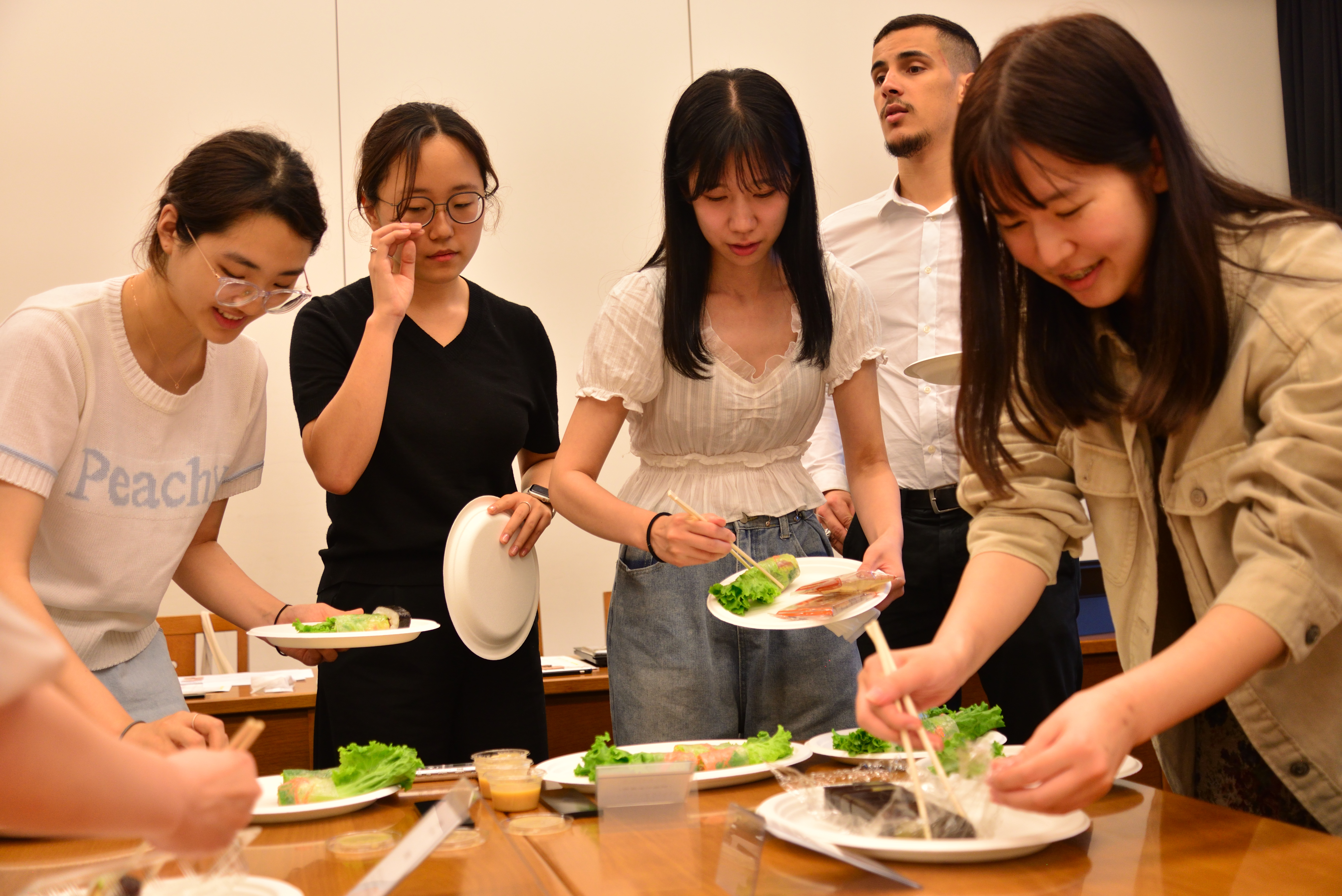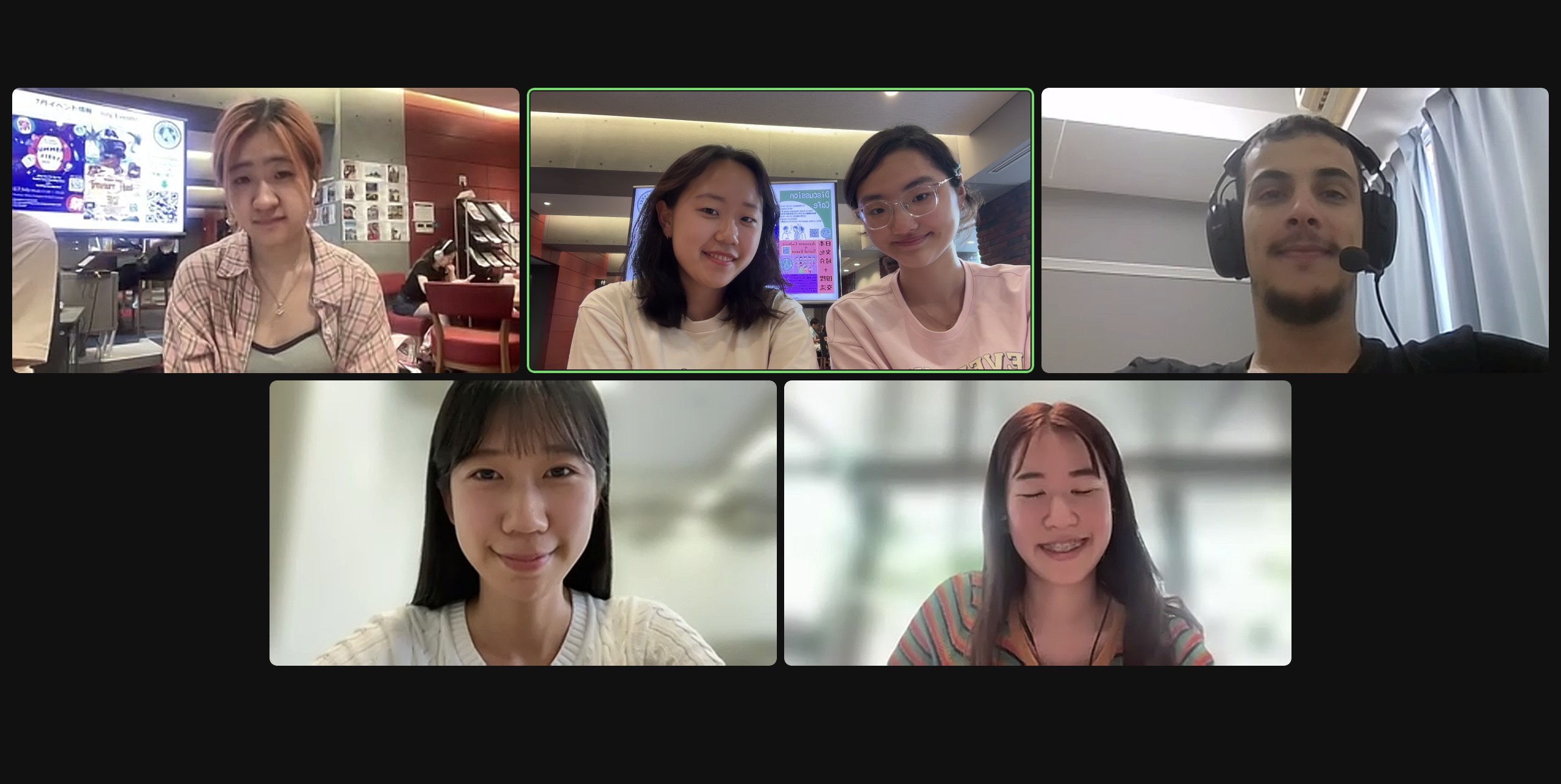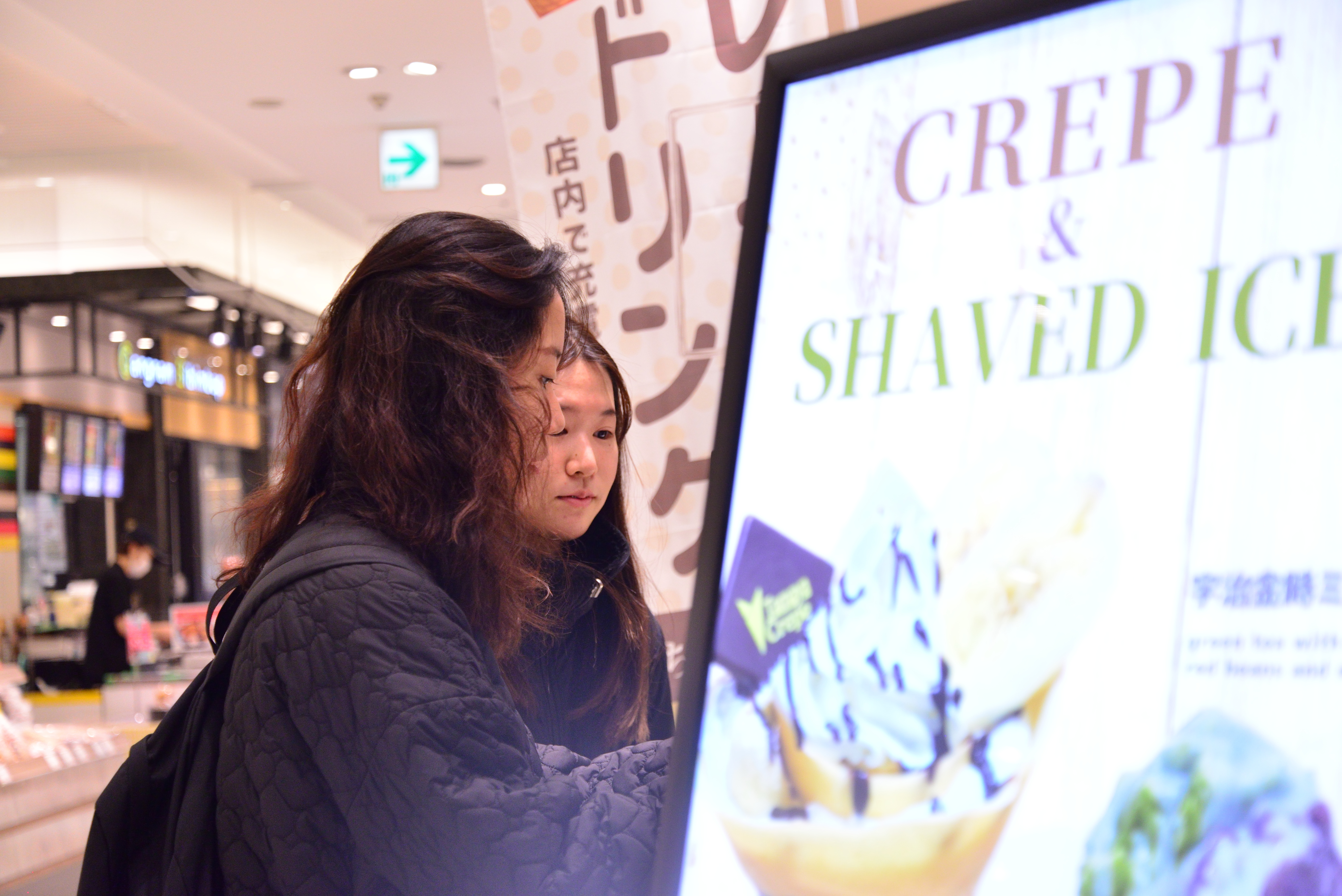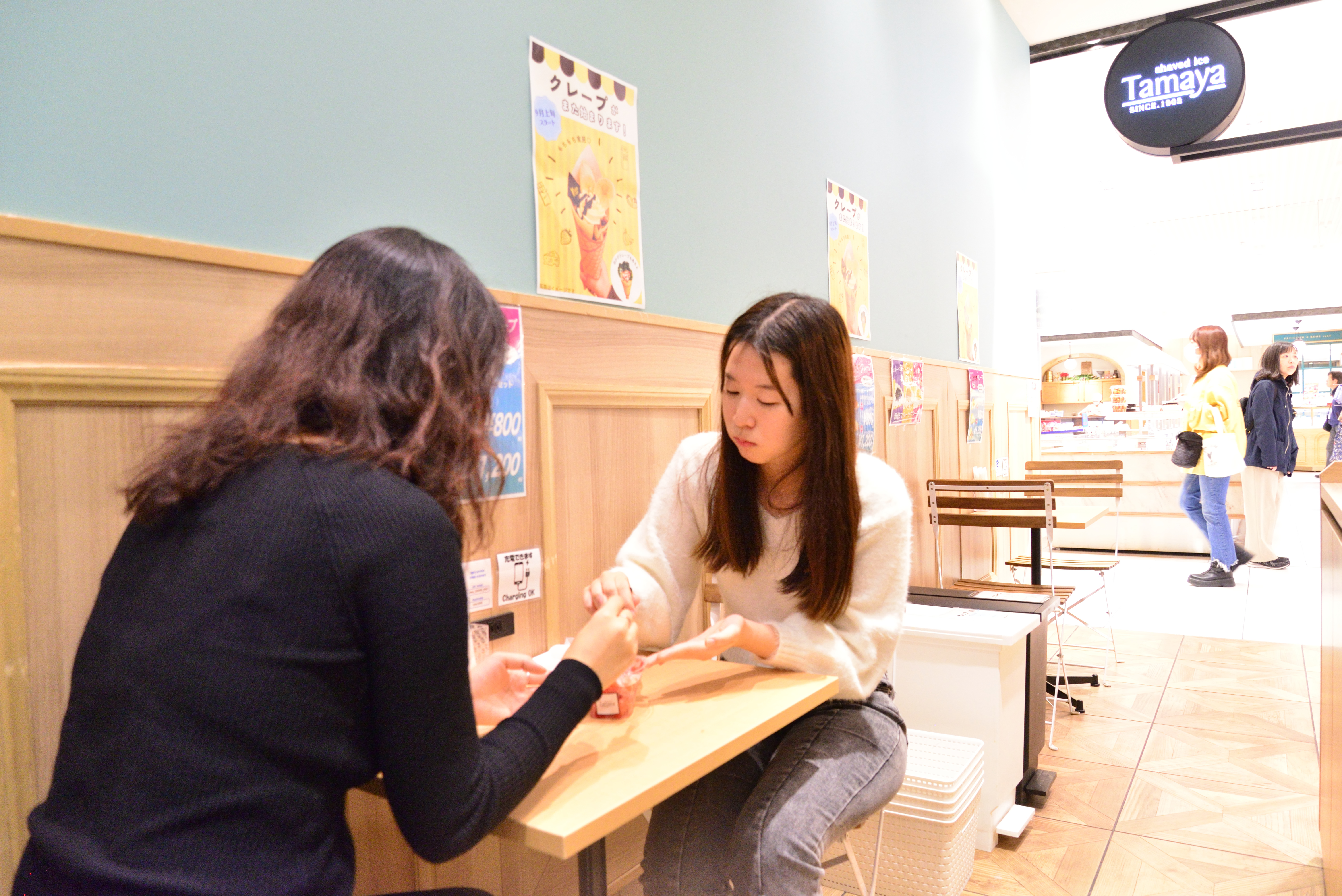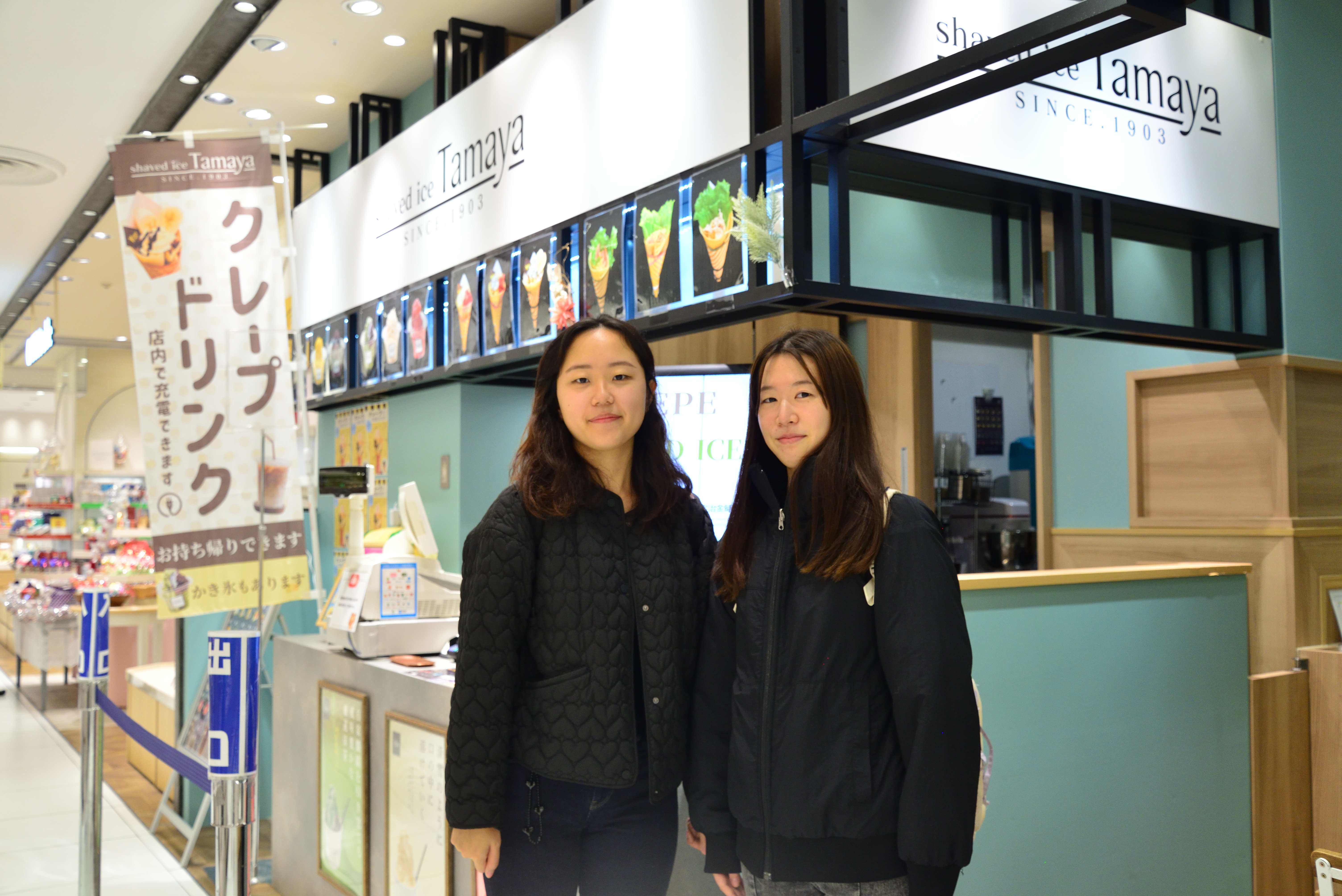Muslim-Friendly Gourmet Guide in Collaboration with Tobu Department Store
Students from the College of Intercultural Communication Promote Food Diversity!
Creating a Muslim-Friendly Gourmet Guide in Collaboration with Tobu Department Store
Students from the College of Intercultural Communication (CIC), including international students, collaborated with Tobu Department Store to create a gourmet guide aimed at assisting in offering hospitality to Muslim guests.
Overcoming the Slow Adoption of Food Diversity with the Help of Students
In an effort to address the sluggish adoption of food diversity, Tobu Department Store Ikebukuro Main Branch (hereinafter “Tobu”) requested collaboration with the CIC. Together with the students, they created the TOBU×RIKKYO Muslim-Friendly Gourmet Guide, a shopping guide that incorporates the concept of halal from Islamic food culture to promote food diversity.
The collaboration involved two official student organizations from the CIC, SEAGULL and LINK CIC. SEAGULL engages in activities to support international students, such as producing intercultural magazines and organizing exchange events. LINK CIC hosts events like career lectures, international student networking gatherings, and international study cafes to provide opportunities and support for students in the CIC.
This article reports on the nearly one-year-long activities of students in promoting food diversity.
[Student Activities]
The collaboration involved two official student organizations from the CIC, SEAGULL and LINK CIC. SEAGULL engages in activities to support international students, such as producing intercultural magazines and organizing exchange events. LINK CIC hosts events like career lectures, international student networking gatherings, and international study cafes to provide opportunities and support for students in the CIC.
This article reports on the nearly one-year-long activities of students in promoting food diversity.
[Student Activities]
| Date | Activity |
|---|---|
| 26-Apr | Kickoff meeting with Tobu. Survey on current handling of halal food. |
| May 10 and 23 | Students drafted the Muslim-friendly standards. |
| 14-Jun | Standards clarified based on survey results. |
| July 5, 12, and 18 | Final standards decided. |
| 26-Jul | Third meeting with Tobu. Guide proposal presented. |
| 18-Oct | Draft proposal of the Gourmet Guide created. |
| 13-Nov | Store interviews conducted. |
| 13-Dec | Consideration of where to distribute the Gourmet Guide. |
| 17-Jan | Gourmet Guide completed and distribution begins |
[Tobu Department Store Ikebukuro Main Branch]
Sharing the Muslim-Friendly Concept
April 26 - Kickoff Meeting with Tobu
On April 26, students and representatives from Tobu held their first meeting.
Among the 10 project participants from Rikkyo University was one Muslim exchange student.
Tobu representatives explained that preliminary surveys of its tenants showed that their halal initiatives were not yet sufficient.
They then requested the students to taste halal products available in the restaurants and food floor to help create an English gourmet guide featuring those products, along with the students’ impressions. They also conveyed their intention to adopt the broader Muslim-friendly concept rather than the stricter halal standards, given the inadequacy of the current initiatives.
[Basic Muslim-friendly Concept of as Presented by Tobu]
・Products that do not contain pork or alcohol as ingredients are considered Muslim-friendly.
・Having an English menu, an English-speaking staff member, the flexibility to remove specific ingredients upon request, etc.
[What IS Halal FOOD?]
Halal food refers to the foods that Muslims are permitted to eat by God. Specifically, this includes vegetables, fruits, grains, legumes, seafood, and beef or chicken that has been processed according to Islamic law. Conversely, foods that are forbidden to eat are called haram food, with pork and alcohol being the most common examples.
Among the 10 project participants from Rikkyo University was one Muslim exchange student.
Tobu representatives explained that preliminary surveys of its tenants showed that their halal initiatives were not yet sufficient.
They then requested the students to taste halal products available in the restaurants and food floor to help create an English gourmet guide featuring those products, along with the students’ impressions. They also conveyed their intention to adopt the broader Muslim-friendly concept rather than the stricter halal standards, given the inadequacy of the current initiatives.
[Basic Muslim-friendly Concept of as Presented by Tobu]
・Products that do not contain pork or alcohol as ingredients are considered Muslim-friendly.
・Having an English menu, an English-speaking staff member, the flexibility to remove specific ingredients upon request, etc.
[What IS Halal FOOD?]
Halal food refers to the foods that Muslims are permitted to eat by God. Specifically, this includes vegetables, fruits, grains, legumes, seafood, and beef or chicken that has been processed according to Islamic law. Conversely, foods that are forbidden to eat are called haram food, with pork and alcohol being the most common examples.
Starting to Establish Muslim-Friendly Standards.
May 10 and 23 - Student Meetings
The students realized that creating the icons to be included in the guide required clearly defined Muslim-friendly standards. The initial draft of these standards, devised by the students through trial and error, included the following specifics:
[First Draft of the Standards for Muslim Friendliness]
・Minimum Requirements
1. Providing food that does not contain alcohol or pork.
2. Clear labeling if any such ingredients are present.
・Preferred Features
3. The flexibility to prepare food without pork or alcohol upon request.
They then drafted the following icons to represent the standards:
1. Providing food that does not contain alcohol or pork
2. Providing food that contains pork
3. Handling food that contains alcohol
4. English menu or English-speaking staff available
[First Draft of the Standards for Muslim Friendliness]
・Minimum Requirements
1. Providing food that does not contain alcohol or pork.
2. Clear labeling if any such ingredients are present.
・Preferred Features
3. The flexibility to prepare food without pork or alcohol upon request.
They then drafted the following icons to represent the standards:
1. Providing food that does not contain alcohol or pork
2. Providing food that contains pork
3. Handling food that contains alcohol
4. English menu or English-speaking staff available
[Icons proposed by students]
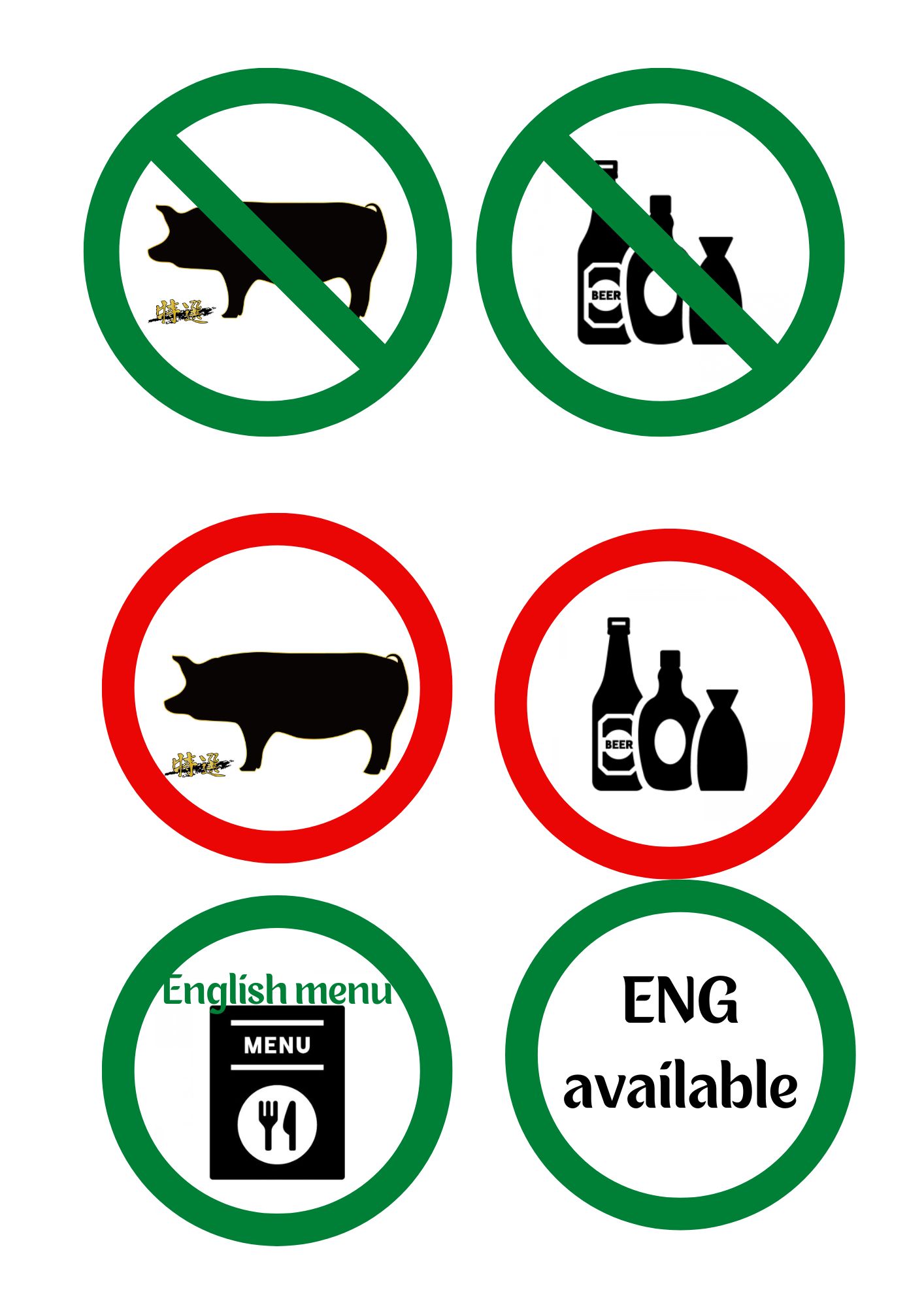
June 14 - Second Meeting with Tobu
Sharing Tenants Survey Results
The purpose of this meeting was to share the survey results conducted by Tobu among its tenants and to discuss the creation of the guide based on these results.
The survey divided tenants into three groups: “sweets,” “fresh food and deli,” and “restaurants and cafes on each floor.” They were asked whether they offer products that do not contain pork or alcohol as ingredients. The results, summarized by category, showed that about 85% of “sweets” and about 83% of “restaurants and cafes on each floor” responded positively. It was also found that many Japanese sweets and Japanese cuisine restaurants responded “Yes.”
The survey divided tenants into three groups: “sweets,” “fresh food and deli,” and “restaurants and cafes on each floor.” They were asked whether they offer products that do not contain pork or alcohol as ingredients. The results, summarized by category, showed that about 85% of “sweets” and about 83% of “restaurants and cafes on each floor” responded positively. It was also found that many Japanese sweets and Japanese cuisine restaurants responded “Yes.”
Some results of the survey
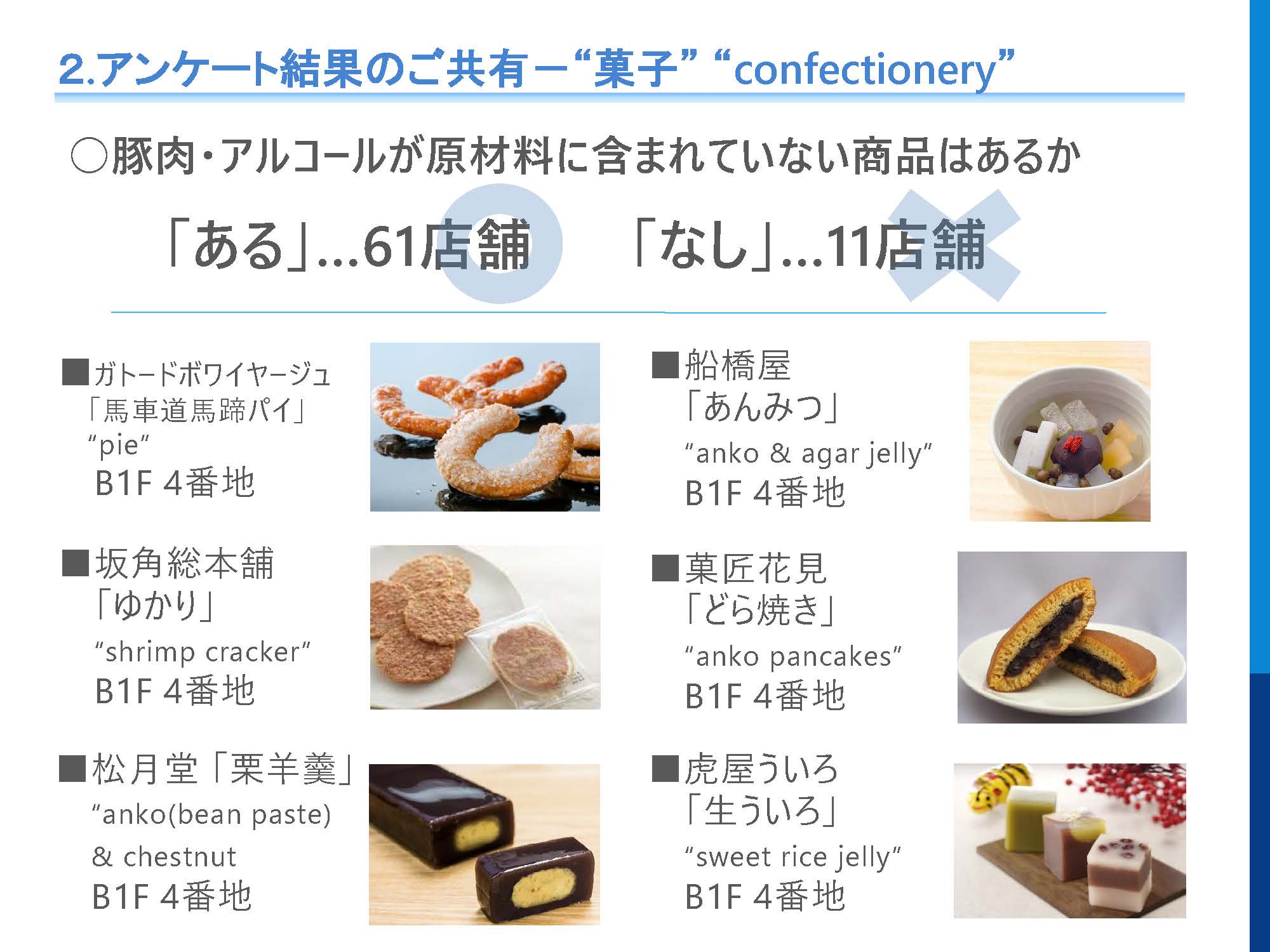
The discussion highlighted the need to clarify Muslim-friendly standards. How to identify the Muslim-friendly tenants from those who answered “Yes”? If the standards are too strict, there may be no tenants to feature; if they are too lenient, there could be a risk of conveying incorrect information.
Some students suggested that the Gourmet Guide only include relatively safe options such as Japanese cuisine and Japanese sweets, but Tobu expressed the desire to feature a wide range of categories: “takeout” “dine-in,” and “restaurants and cafes on each floor.”
It was agreed that the students would create Muslim-friendly standards and develop a draft guide to be shared at the next meeting based on these standards.
Some students suggested that the Gourmet Guide only include relatively safe options such as Japanese cuisine and Japanese sweets, but Tobu expressed the desire to feature a wide range of categories: “takeout” “dine-in,” and “restaurants and cafes on each floor.”
It was agreed that the students would create Muslim-friendly standards and develop a draft guide to be shared at the next meeting based on these standards.
Students engaged in serious discussion.
Food tasting was also conducted on that day.
July 5, 12 and 18 - Student Meetings
Muslim-friendly Standards Finalized!
How should the Muslim-friendly standards be defined? The students referred to the Muslim Friendly Certification by Muslim Professional Japan Association and the Halal Certification by Japan Halal Business Association. They also studied restaurant websites and menus to thoroughly consider the standards.
The students were perplexed by the lack of consistent standards in the examples of Muslim-friendly initiatives in Japan.
Standards varied widely from case to case, such as whether non-pork meats were processed according to Muslim customs, whether dedicated utensils were used, whether the chef was Muslim, and whether there was a prayer room within the facility. Moreover, not all Muslims think alike. For example, some of them strictly avoid even the alcohol spontaneously produced in the process of refining soy sauce.
It is difficult to detail each meat processing method. However, standards that are too vague can lead to trouble. Furthermore, the intended readers of this English guide are primarily from non-English speaking countries, so it cannot easily convey detailed information. With this in mind, the students decided on the following simple and clear standards.
[Muslim-friendly Standards (Final Version)]
・No pork is used.
・No alcohol is used.
(except when an alcohol-free option is available)
Cleary stating whether dedicated utensils can be provided.
The students were perplexed by the lack of consistent standards in the examples of Muslim-friendly initiatives in Japan.
Standards varied widely from case to case, such as whether non-pork meats were processed according to Muslim customs, whether dedicated utensils were used, whether the chef was Muslim, and whether there was a prayer room within the facility. Moreover, not all Muslims think alike. For example, some of them strictly avoid even the alcohol spontaneously produced in the process of refining soy sauce.
It is difficult to detail each meat processing method. However, standards that are too vague can lead to trouble. Furthermore, the intended readers of this English guide are primarily from non-English speaking countries, so it cannot easily convey detailed information. With this in mind, the students decided on the following simple and clear standards.
[Muslim-friendly Standards (Final Version)]
・No pork is used.
・No alcohol is used.
(except when an alcohol-free option is available)
Cleary stating whether dedicated utensils can be provided.
July 26 - Third Meeting with Tobu
Students Presented the Draft Guide Based on the Standards! How Was It Received?
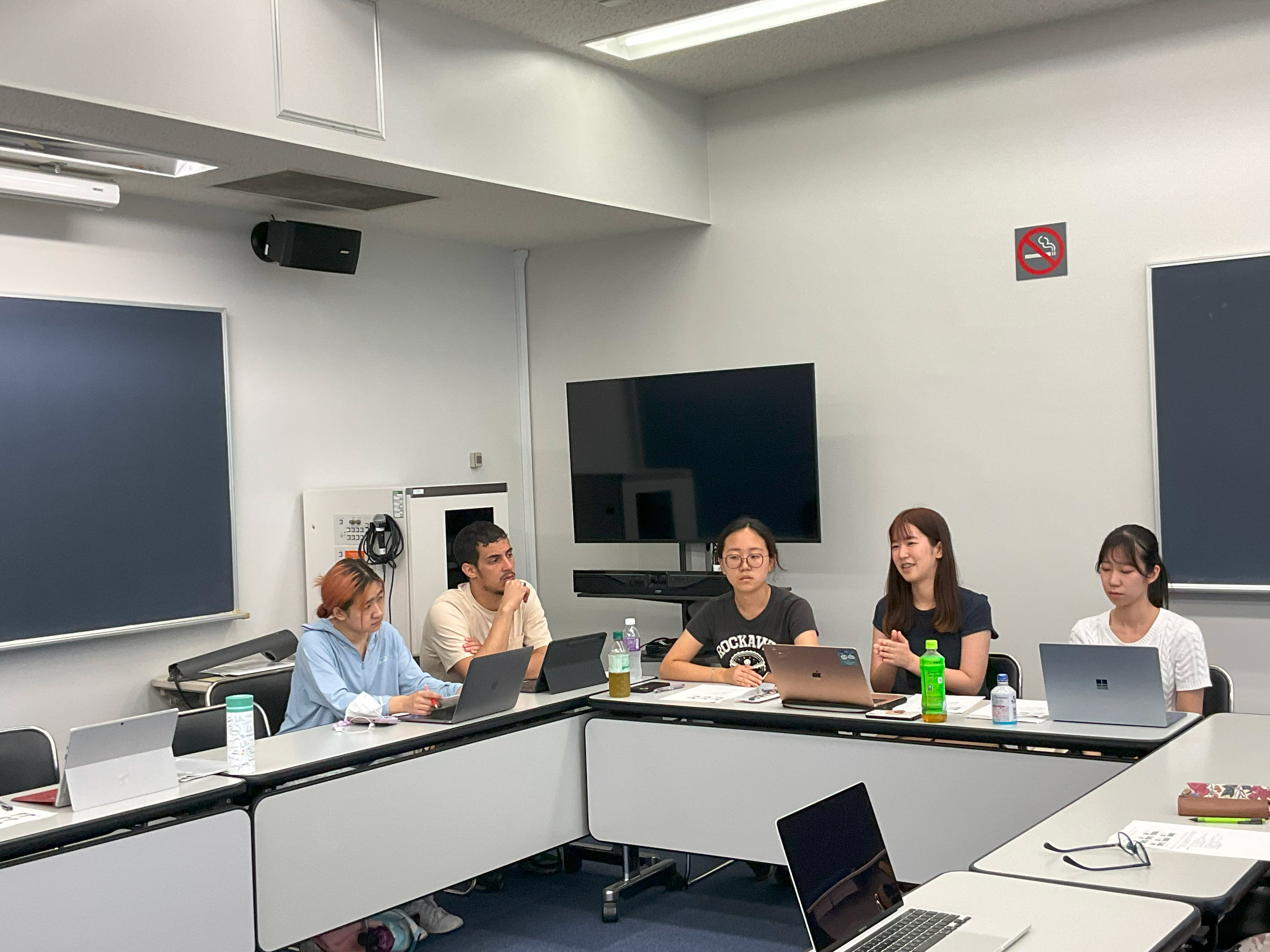
The students presented three proposals of the guide to Tobu, based on the standards.
[Students’ Guide Proposals]
Proposal 1: Feature all tenants within Tobu, using icons to convey the characteristics of each tenant.
Proposal 2: Select tenants based on the Muslim-friendly standards shared among the students.
Proposal 3: Feature only the restaurants selected by the students, while including all tenants in the basement food section with icons.
Tobu chose Proposal 2. They wanted to incorporate as much student perspective as possible and feature the tenants picked by the students in the Gourmet Guide.
[Students’ Guide Proposals]
Proposal 1: Feature all tenants within Tobu, using icons to convey the characteristics of each tenant.
Proposal 2: Select tenants based on the Muslim-friendly standards shared among the students.
Proposal 3: Feature only the restaurants selected by the students, while including all tenants in the basement food section with icons.
Tobu chose Proposal 2. They wanted to incorporate as much student perspective as possible and feature the tenants picked by the students in the Gourmet Guide.
[Rendering of proposed guide 2]
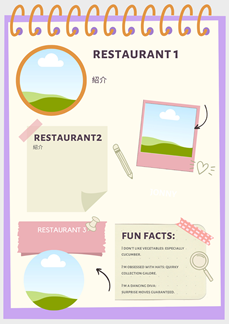
October 18 - Fourth Meeting with Tobu
Students Presented the Gourmet Guide Draft! How Was It Received?
With the direction of the chosen guide, both the students and Tobu presented their respective drafts of the gourmet guide.
The students’ proposal included a basic information page to clearly provide necessary information and placed icons to enhance visual comprehension.
Tobu’s draft focused on the layout of the introduction pages, detailing how many restaurants and other food vendors should be on each page.
[Students’ Gourmet Guide Draft]
The students’ proposal included a basic information page to clearly provide necessary information and placed icons to enhance visual comprehension.
Tobu’s draft focused on the layout of the introduction pages, detailing how many restaurants and other food vendors should be on each page.
[Students’ Gourmet Guide Draft]
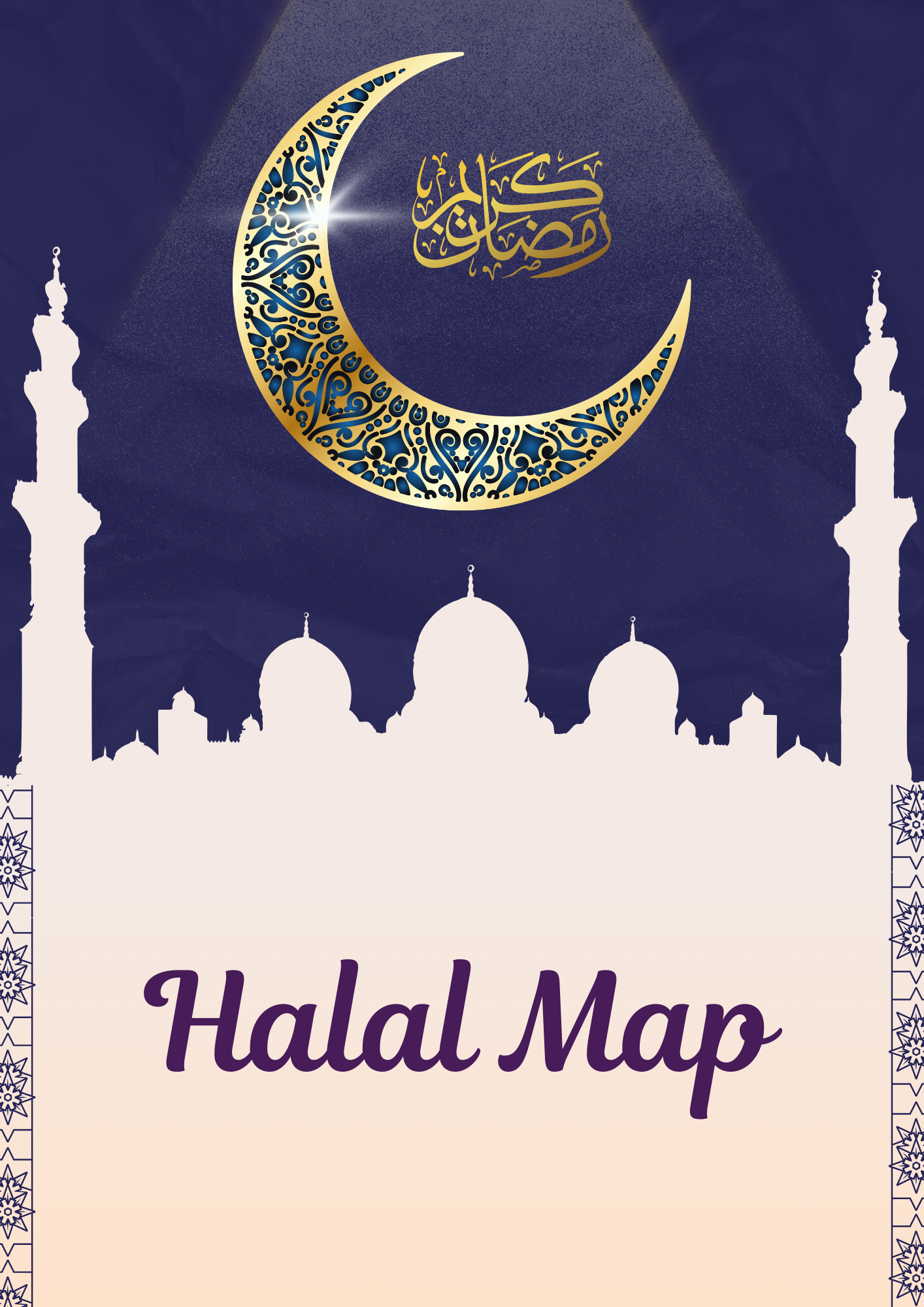
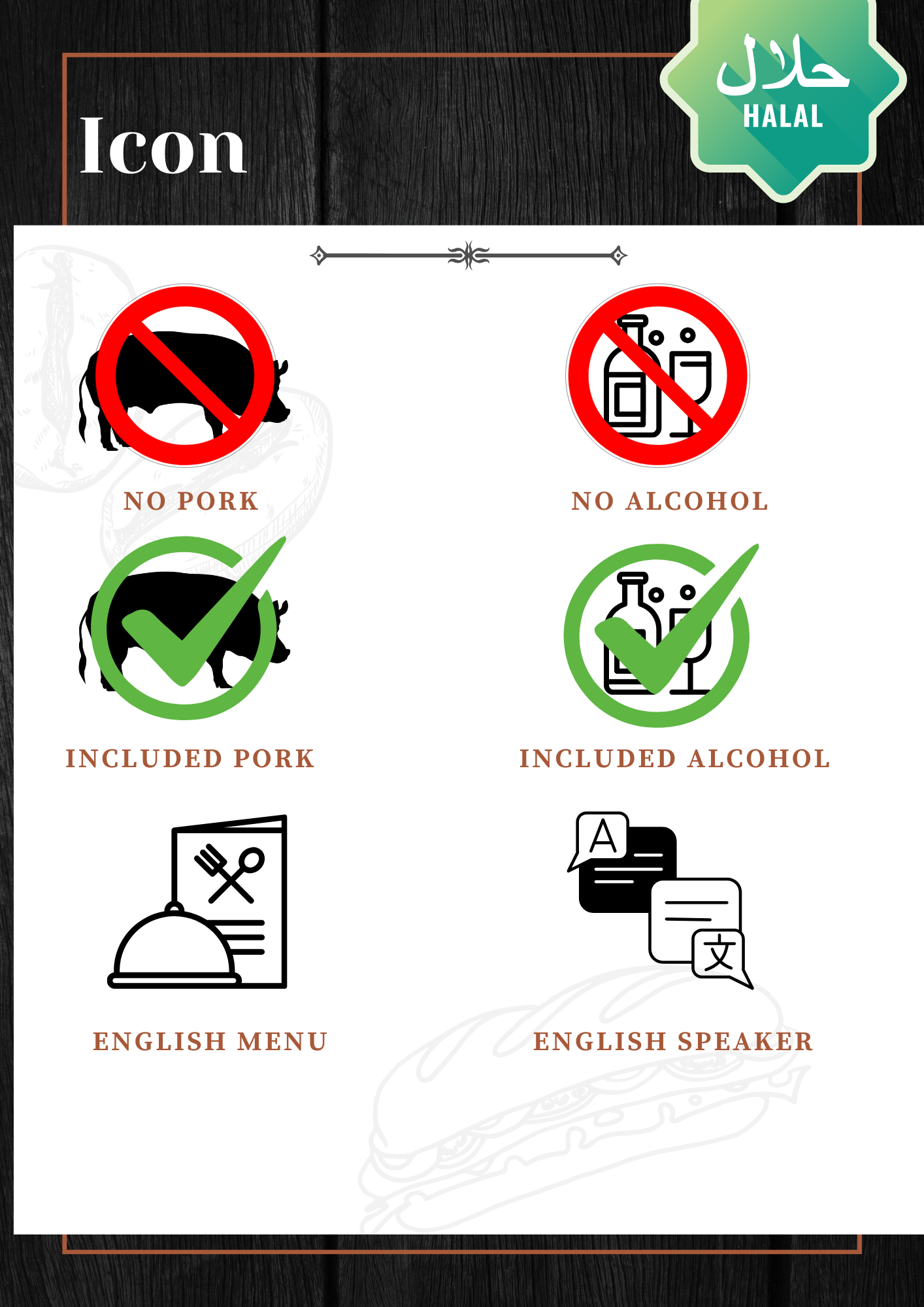

The icons and basic information proposed by the students were well received by Tobu.
Both sides decided to combine the strengths of their respective proposals to structure the guide. As a result, the guide was set to be A5-sized with 8 pages. The basic information was featured on the second page. The icons were narrowed down to five types. Restaurant reviews were also included.
Both sides decided to combine the strengths of their respective proposals to structure the guide. As a result, the guide was set to be A5-sized with 8 pages. The basic information was featured on the second page. The icons were narrowed down to five types. Restaurant reviews were also included.
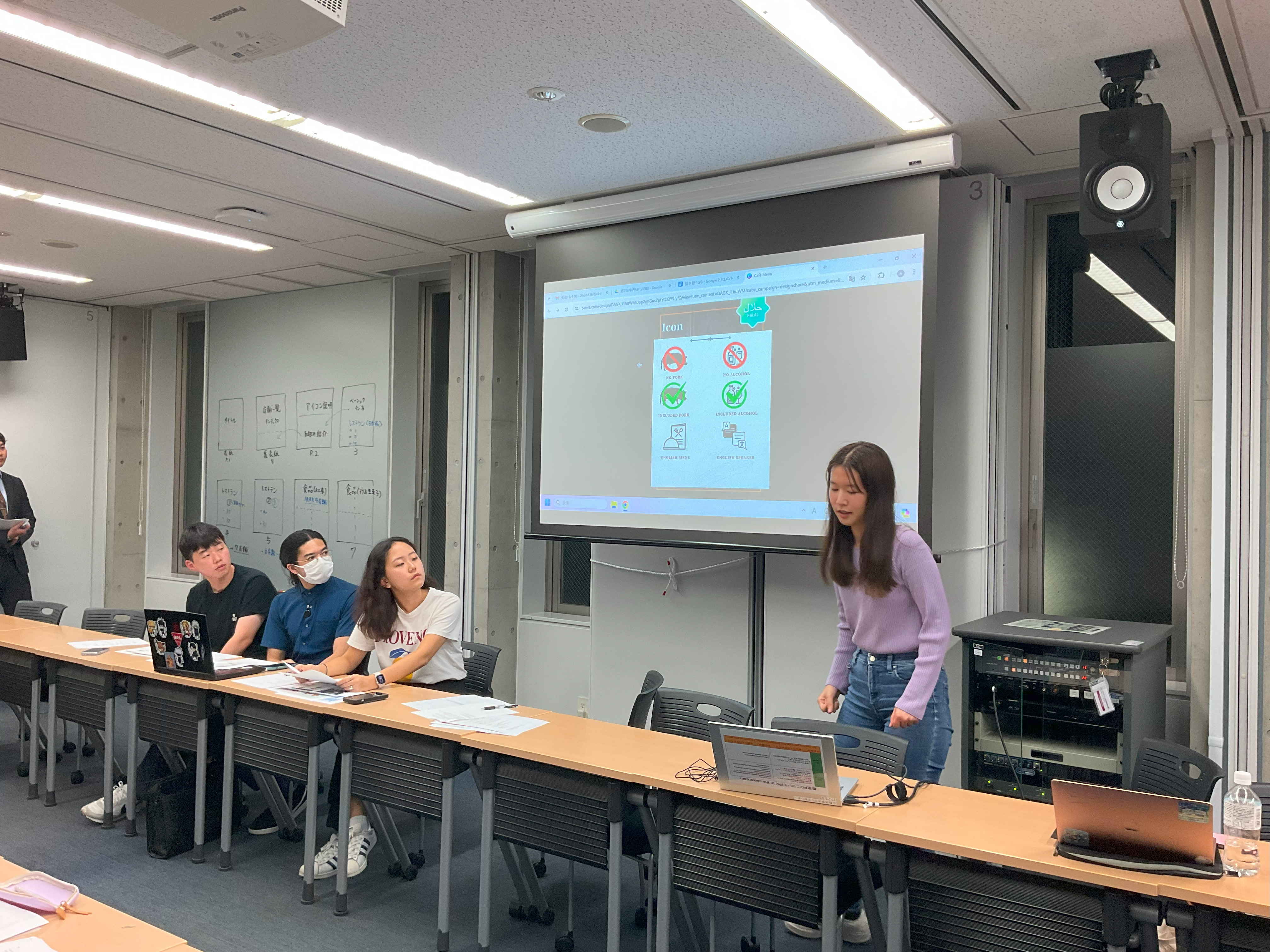
Explaining the draft guide with a screen.
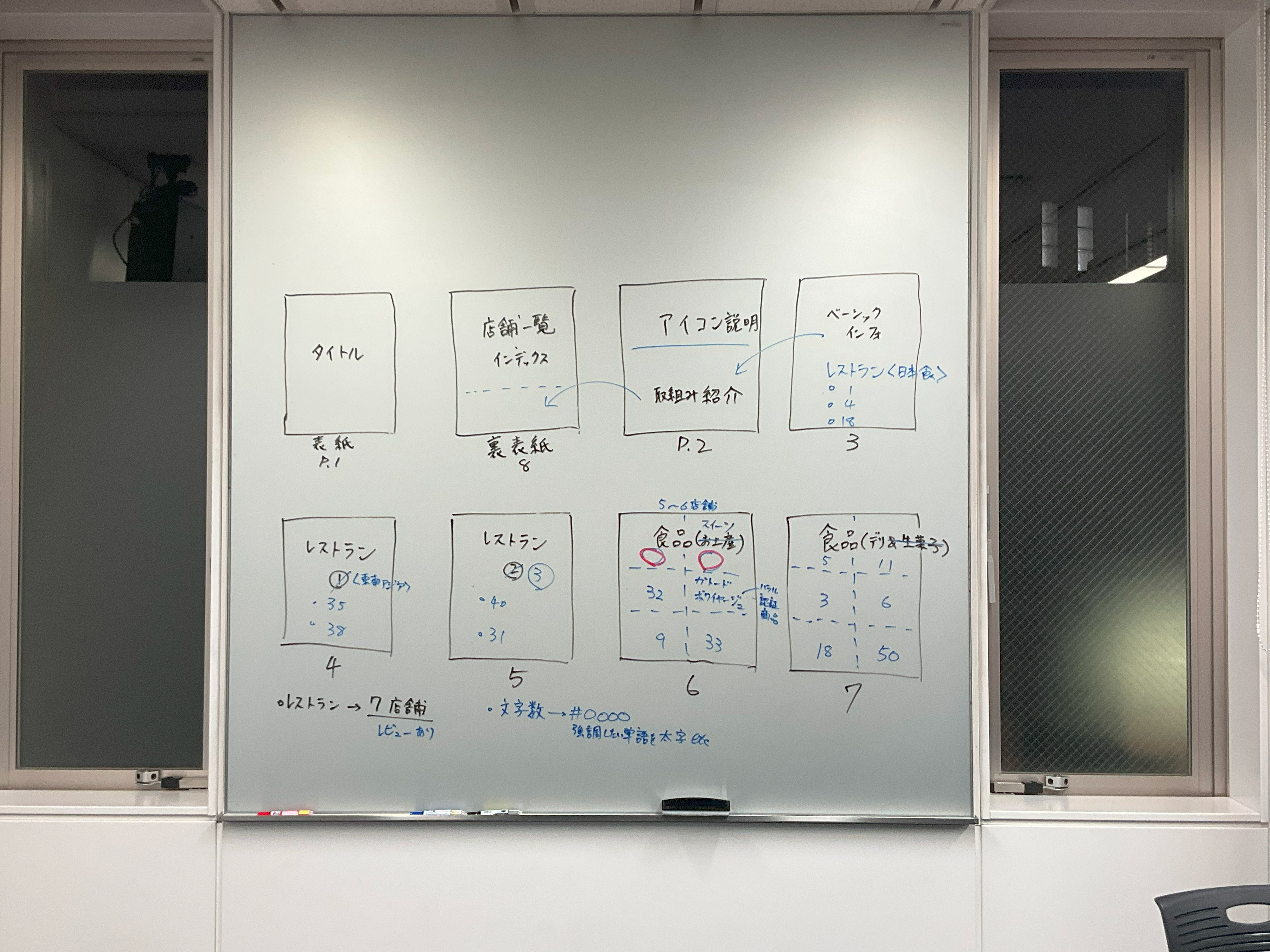
Considering the structure with a whiteboard.
Selection of Included Tenants and Preparation for Information Gathering
Having finalized the Muslim-friendly standards for in July, the students took the lead in selecting tenants to be featured in the guide. They used information from the survey conducted by Tobu to make selections based on the established standards. The selected tenants were proposed at the October 18 meeting. Tobu then made the final adjustments, resulting in a total of 19 tenants: seven restaurants and 12 sweets and deli vendors.
The students also prepared questions for tenants in order to gather content for the guide. These questions reflected the established standards, such as, “Is it possible to use separate dishes for halal and non-halal meals?”
The students also prepared questions for tenants in order to gather content for the guide. These questions reflected the established standards, such as, “Is it possible to use separate dishes for halal and non-halal meals?”
November 13 – Fieldwork
Finally, Visited Tenants to Gather Information!
On November 13, the students met in “eatobu,” the food section on the first basement floor of Tobu Department Store to gather information for the gourmet guide. They visited tenants as customers, purchased products, tasted them, and recorded their impressions and notes. Some necessary information had already been obtained through preliminary surveys, in order to avoid having to conduct on-site interviews out of respect for the busy tenants.
Two students visited a shaved ice vendor Tamaya. They bought strawberry milk flavored shaved ice. After thorough observation, they scooped it up with a spoon and took a bite.
“It’s so smooth!” “The strawberries are refreshing!”
Despite being there for investigation, they were pleasantly surprised by the deliciousness.
Tamaya was the last tenant on their scheduled visits. By then, the students had already completed 18 out of the 19 visits to the tenants to be featured in the guide.
Asuka Uchiyama, a member of the investigation team and a fourth-year undergraduate student, said, “I found it difficult to define what soy sauce is” during her tenant visits and writing process. Jimin Jun, another member and a third-year undergraduate student, said, “It was challenging for me to make recommendations. It made me realize the difficulties Muslims face.”
Two students visited a shaved ice vendor Tamaya. They bought strawberry milk flavored shaved ice. After thorough observation, they scooped it up with a spoon and took a bite.
“It’s so smooth!” “The strawberries are refreshing!”
Despite being there for investigation, they were pleasantly surprised by the deliciousness.
Tamaya was the last tenant on their scheduled visits. By then, the students had already completed 18 out of the 19 visits to the tenants to be featured in the guide.
Asuka Uchiyama, a member of the investigation team and a fourth-year undergraduate student, said, “I found it difficult to define what soy sauce is” during her tenant visits and writing process. Jimin Jun, another member and a third-year undergraduate student, said, “It was challenging for me to make recommendations. It made me realize the difficulties Muslims face.”
How Is Progress on the Gourmet Guide Production?
Each time they finished gathering information about a tenant, the students drafted an article about it. The challenge of the Gourmet Guide was not only to explain how Muslim-friendly the tenants were, but also to vividly describe each product’s texture and taste in a way that would entice readers to try it as a gourmet guide.
Each time a draft was completed, it was placed on a page to check the layout. Photos taken by the students added a handmade touch. The design work was outsourced to a design company. The production of the gourmet guide was entering its final stages.
Each time a draft was completed, it was placed on a page to check the layout. Photos taken by the students added a handmade touch. The design work was outsourced to a design company. The production of the gourmet guide was entering its final stages.
December 13 - Fifth Meeting with Tobu
Discussing Where to Distribute the Gourmet Guide
They discussed where the finished guide would be placed for people to obtain. The main target audience is Muslim visitors and residents in Japan. They considered locations and facilities around Ikebukuro that are frequently visited by Muslims.
The locations proposed on that day included public facilities such as ward tourist information centers, as well as commercial facilities like hotels. Additionally, it was decided to make the guide available on Rikkyo University’s website, SEAGULL and LINKCIC’s Instagram accounts, and Tobu Department Store’s website.
The locations proposed on that day included public facilities such as ward tourist information centers, as well as commercial facilities like hotels. Additionally, it was decided to make the guide available on Rikkyo University’s website, SEAGULL and LINKCIC’s Instagram accounts, and Tobu Department Store’s website.
January 17 - Sixth Meeting with Tobu
Finally, the Gourmet Guide is Complete and Ready for Distribution!
The gourmet guide was finally complete! The delivery date was January 10. The unveiling took place at the sixth meeting held on January 17.
“Look how beautifully this photo turned out!”
“I cannot believe what I wrote is really on the page!”
One student said, “I wasn’t sure which parts of the process I was involved in, but seeing the finished product, now I truly understand my role. That makes me feel deeply moved.”
“Look how beautifully this photo turned out!”
“I cannot believe what I wrote is really on the page!”
One student said, “I wasn’t sure which parts of the process I was involved in, but seeing the finished product, now I truly understand my role. That makes me feel deeply moved.”
Completed Muslim-Friendly Gourmet Guide
*Information as of January 10, 2025.
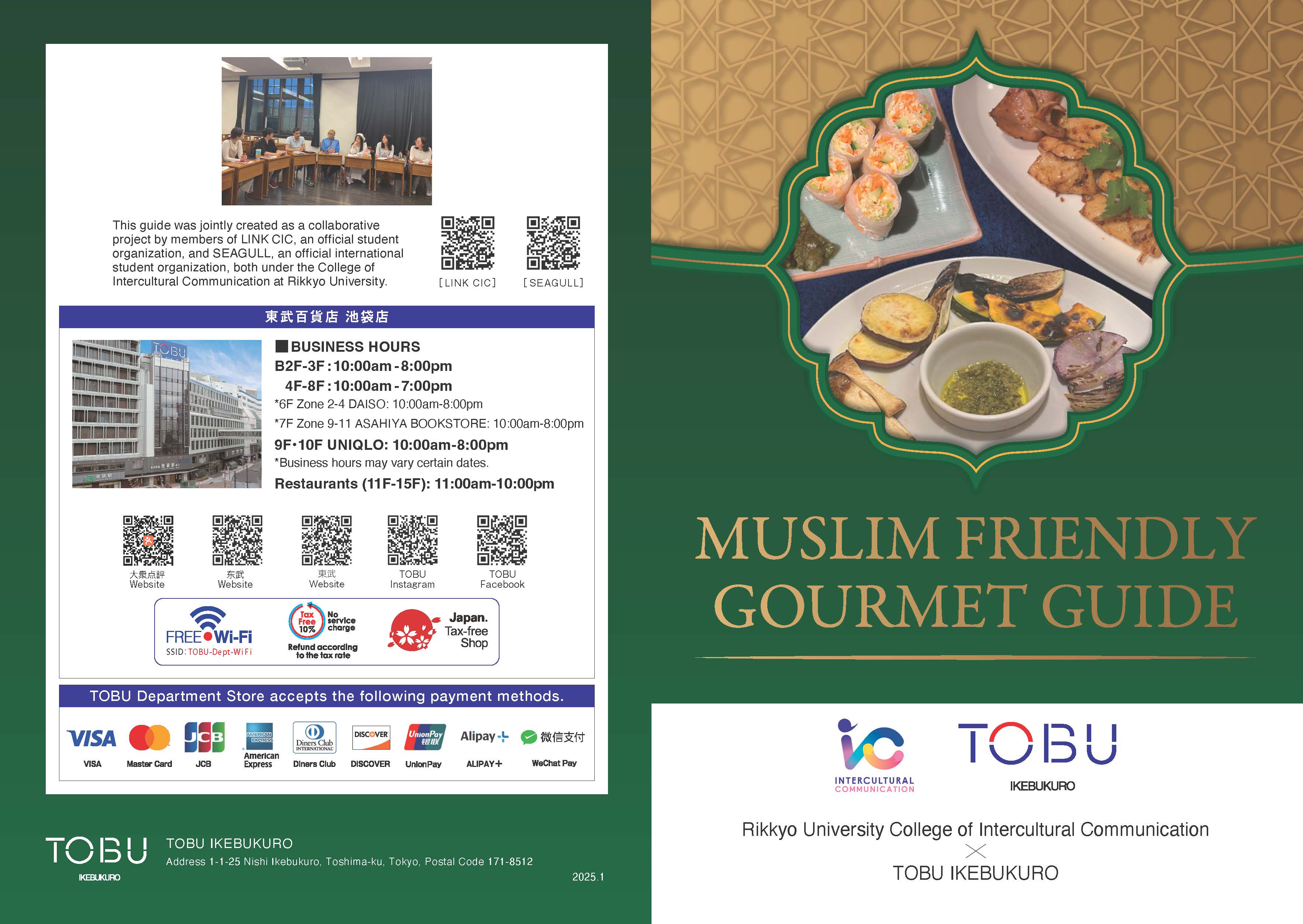
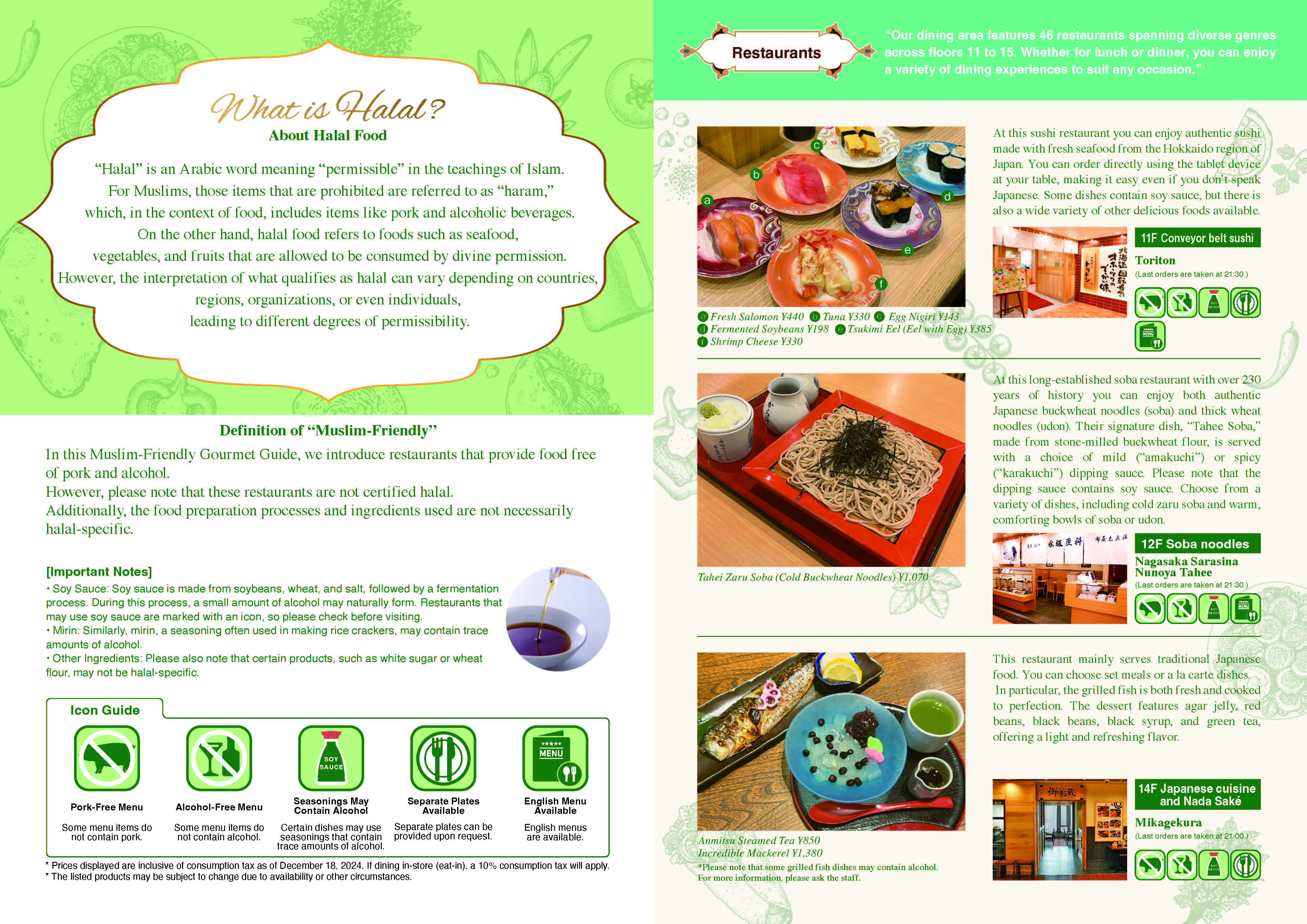
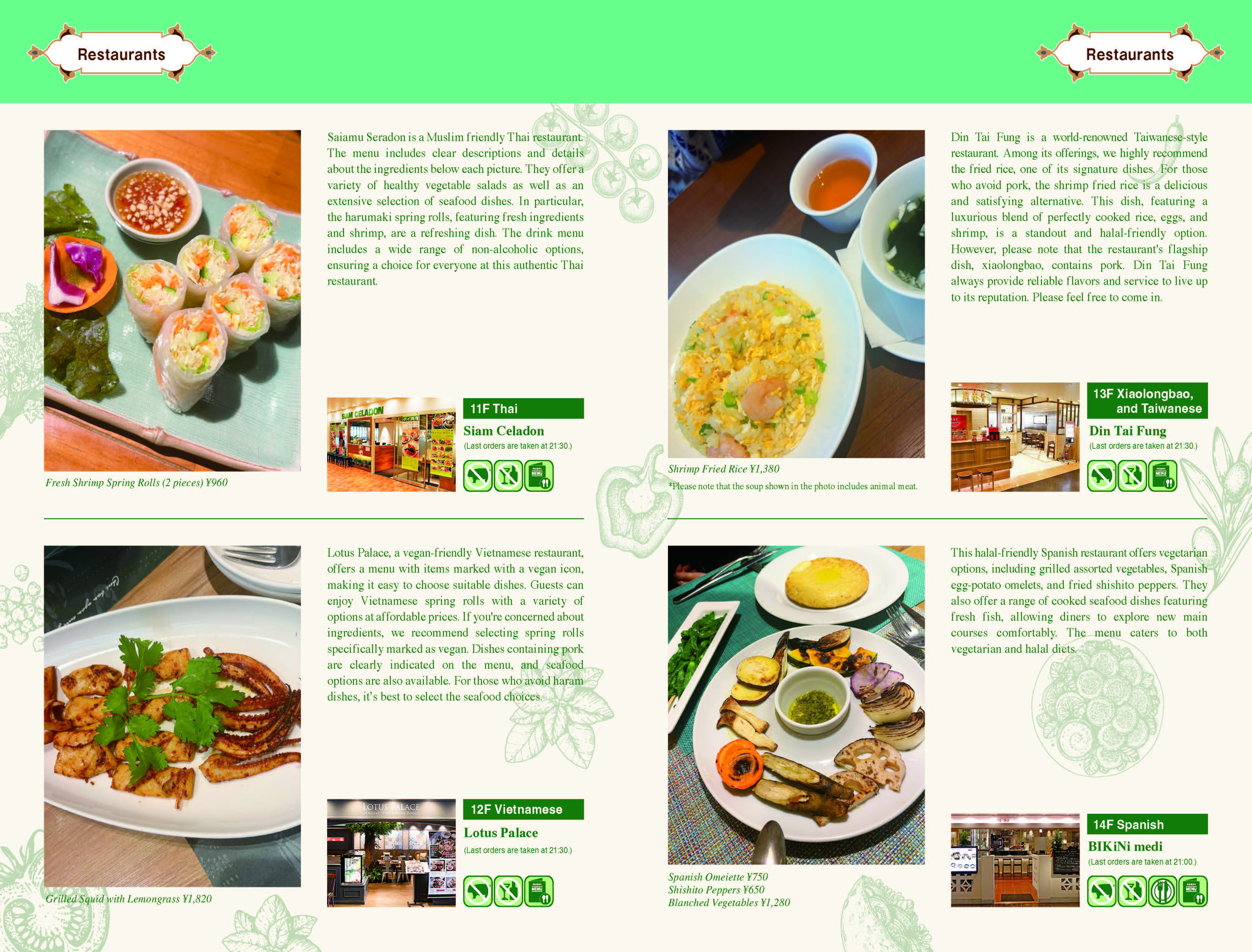
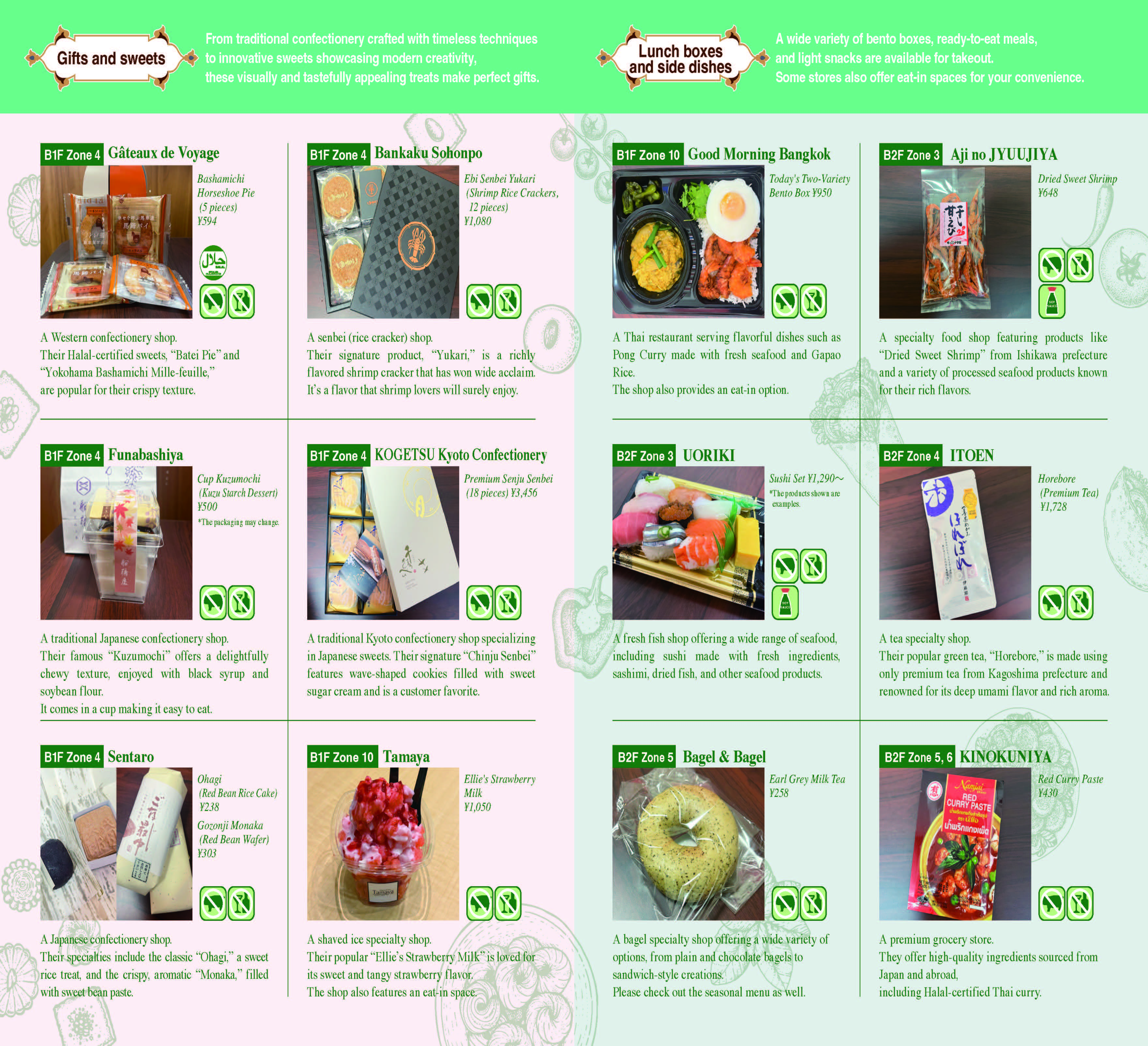
[Key Points of the Muslim-Friendly Gourmet Guide]
・Created based on the Muslim-friendly Standards established by the students.
・Featuring 7 restaurants, 6 gift and sweets vendors, and 6 boxed lunch and deli vendors.
・Basic Information Page that explains essential information.
・Icons are used to enhance visual comprehension.
・Created based on the Muslim-friendly Standards established by the students.
・Featuring 7 restaurants, 6 gift and sweets vendors, and 6 boxed lunch and deli vendors.
・Basic Information Page that explains essential information.
・Icons are used to enhance visual comprehension.
Reflecting on the Project
We asked two participating students what they think now that the Gourmet Guide is complete.
Q: What was the most challenging part of the Gourmet Guide production process?
A: Establishing the Muslim-friendly standards. Considering that the Guide is aimed at Muslim tourists, we focused on being clear to avoid confusing people with complicated English explanations. (Asuka Uchiyama, fourth-year undergraduate student)
Q: What do you think are the best aspects of the Guide?
A: Readers can see how we felt and what we experienced throughout the production process. It brings together all the information, texts, and photos we created. (Jimin Jun, third-year undergraduate student)
Q: What insights and learning did you gain from participating in the industry-academia collaboration project/regional collaboration project?
A: Talking with people who have different perspectives from students made me realize the importance of thinking about how to make things happen, rather than just doing what I know or want to do. (Asuka Uchiyama, fourth-year undergraduate student))
Q: How did your experiences and perspective as an international student contribute?
A: Living in Japan as a foreigner allowed me to view products from a different perspective than Japanese people. I found myself enjoying the process of listening to opinions of the Muslim member and exploring together with Japanese students. (Jimin Jeon, third-year undergraduate student)
Q: What insights and learning did you gain from the project?
A: I learned about halal, which I had not known well. It was challenging for me to create a project to inform others about it. I learned how to understand something first and then to communicate it to others. (Jimin Jeon, third-year undergraduate student)
Q: Did your way of thinking change significantly before and after participating in the project?
A: I realized that a society that is easy for me to live in may not be comfortable for others. I became more aware of the perspectives of people from other cultural backgrounds living in Japan. (Asuka Uchiyama, fourth-year undergraduate student)
Q: What was the most challenging part of the Gourmet Guide production process?
A: Establishing the Muslim-friendly standards. Considering that the Guide is aimed at Muslim tourists, we focused on being clear to avoid confusing people with complicated English explanations. (Asuka Uchiyama, fourth-year undergraduate student)
Q: What do you think are the best aspects of the Guide?
A: Readers can see how we felt and what we experienced throughout the production process. It brings together all the information, texts, and photos we created. (Jimin Jun, third-year undergraduate student)
Q: What insights and learning did you gain from participating in the industry-academia collaboration project/regional collaboration project?
A: Talking with people who have different perspectives from students made me realize the importance of thinking about how to make things happen, rather than just doing what I know or want to do. (Asuka Uchiyama, fourth-year undergraduate student))
Q: How did your experiences and perspective as an international student contribute?
A: Living in Japan as a foreigner allowed me to view products from a different perspective than Japanese people. I found myself enjoying the process of listening to opinions of the Muslim member and exploring together with Japanese students. (Jimin Jeon, third-year undergraduate student)
Q: What insights and learning did you gain from the project?
A: I learned about halal, which I had not known well. It was challenging for me to create a project to inform others about it. I learned how to understand something first and then to communicate it to others. (Jimin Jeon, third-year undergraduate student)
Q: Did your way of thinking change significantly before and after participating in the project?
A: I realized that a society that is easy for me to live in may not be comfortable for others. I became more aware of the perspectives of people from other cultural backgrounds living in Japan. (Asuka Uchiyama, fourth-year undergraduate student)
Comments from Matsushima, Okayasu, and Tanabe
Sales Promotion&Planning Section, Sales Promotion Division, Tobu Department Store, Ikebukuro Main Branch
Q: What prompted you to entrust this project to the students?
A: It all started when we saw the halal map created by the SEAGULL team. That map features halal food restaurants around Ikebukuro. We wanted to create a Tobu Department Store version of this halal map, leveraging the students’ experiences and their communication skills regarding different cultures. That’s why we approached them to collaborate on this project.
Another reason is that, since we don’t have any foreign employees, we wanted to include the valuable perspectives of insightful students, especially international students, in the Guide.
Q: What are your overall impressions of the project?
A: The students approached the project with great enthusiasm.
It was impressive to see them actively exchanging ideas and earnestly working to understand Muslims from a unique student perspective. For us, it was a very meaningful and educational experience.
We are delighted to see Muslims actually picking up and opening the Guide, a result of our collaboration with the students.
We extend our heartfelt gratitude to the professors who supported this project, and we hope that the participating students feel they have learned and grown, making this a fruitful endeavor for their future.
Thank you very much for this opportunity.
A: It all started when we saw the halal map created by the SEAGULL team. That map features halal food restaurants around Ikebukuro. We wanted to create a Tobu Department Store version of this halal map, leveraging the students’ experiences and their communication skills regarding different cultures. That’s why we approached them to collaborate on this project.
Another reason is that, since we don’t have any foreign employees, we wanted to include the valuable perspectives of insightful students, especially international students, in the Guide.
Q: What are your overall impressions of the project?
A: The students approached the project with great enthusiasm.
It was impressive to see them actively exchanging ideas and earnestly working to understand Muslims from a unique student perspective. For us, it was a very meaningful and educational experience.
We are delighted to see Muslims actually picking up and opening the Guide, a result of our collaboration with the students.
We extend our heartfelt gratitude to the professors who supported this project, and we hope that the participating students feel they have learned and grown, making this a fruitful endeavor for their future.
Thank you very much for this opportunity.
Conclusion
The students developed the Muslim-friendly standards, selected tenants, gathered information, wrote drafts, took photos, and completed the Gourmet Guide on their own. This experience was the essence of intercultural communication, as they learned to understand cultures different from their own in order to clearly explain them to others. The moment they saw the completed guide, their faces lit up with joy and they felt a deep sense of accomplishment and growth from this year-long journey.



